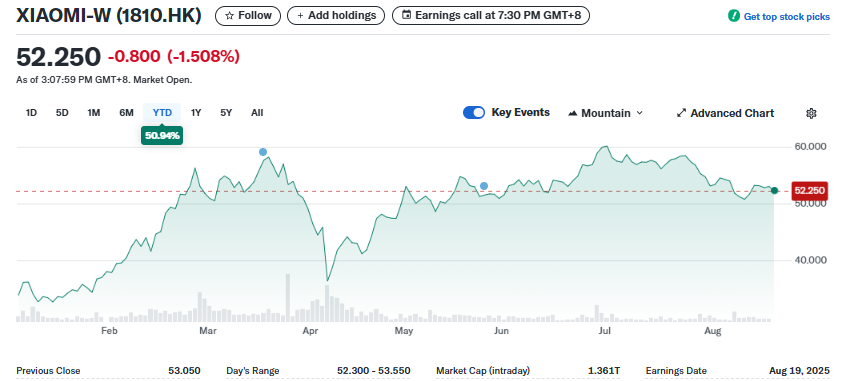TLDRs;
- Xiaomi’s stock has surged over 50% in 2025, adding $120B in value thanks to its EV expansion.
- Smartphone sales growth slows, with China gains offset by India losses, pressuring margins despite EV optimism.
- Analysts expect smartphone revenue to grow just 3.9%, its slowest pace since 2023, raising concerns about sustainability.
- Investor focus shifts to Xiaomi’s EV strategy, though rising short interest signals caution around long-term profitability.
Xiaomi Corporation (XIACF) has experienced a remarkable rally in 2025, with its stock soaring more than 50% year-to-date.
The surge, which has added roughly $120 billion in market value, comes as investors pile into the company’s growing electric vehicle (EV) business.
While enthusiasm for Xiaomi’s EV expansion has been a major driver of the rally, concerns are mounting over slowing growth in its traditional smartphone division, which still accounts for a significant portion of revenue.

Smartphones remain a weak spot
Despite the EV-fueled optimism, Xiaomi continues to grapple with challenges in its smartphone operations. Analysts expect the company’s upcoming quarterly results to show softer margins and weaker-than-expected revenue from phones, even as unit shipments modestly improved in some markets.
According to Counterpoint Research, Xiaomi’s smartphone market share in China rose to 15.7% in Q2, up from 14.7% a year earlier. Aggressive discounts and promotions helped drive that growth, though the company still trails Huawei, Vivo, and Oppo.
In India, however, performance slipped, with market share dropping to 8% from 13% in the same period last year. Analysts estimate that smartphone revenue grew only 3.9% year-on-year, its slowest pace since 2023, underscoring how competitive pricing and margin pressures continue to weigh on the business.
EV expansion reshapes investor confidence
The rally in Xiaomi shares is being powered by its aggressive EV ambitions, which are reshaping perceptions of the company beyond smartphones.
Xiaomi’s foray into electric vehicles has attracted significant investor attention, positioning it as more than just a consumer electronics maker.
The company has emphasized its long-term strategy of building an integrated ecosystem where smartphones, smart devices, and EVs all connect seamlessly. This pitch has resonated with investors eager for exposure to China’s rapidly expanding EV sector, which remains a key pillar of government policy support.
Still, the surge has not been without volatility. Since early July, Xiaomi’s shares have fallen by about 12%, even as short interest has climbed to more than 0.7% of free float. Analysts suggest that while the EV story remains compelling, near-term risks tied to smartphone weakness and profitability are hard to ignore.
Market leadership remains volatile
Xiaomi’s challenges in smartphones also highlight the highly volatile nature of China’s mobile market. Market leadership in China has historically shifted quickly, with Huawei, Oppo, Vivo, and Xiaomi trading places in rankings as consumer demand fluctuates.
Xiaomi briefly led the market in Q1 2025 with a 19% share, but Huawei reclaimed the top spot in Q2 with 18%, underscoring the fragility of leadership even among top vendors. The top five players now control about 90% of the market, up from 73% just a few years ago, meaning competition among leading firms has only intensified.
The current slowdown is not the first challenge Xiaomi has faced in this space. Back in 2016, the company saw shipments fall dramatically from 70 million to 41 million, largely due to supply chain and organizational issues.

